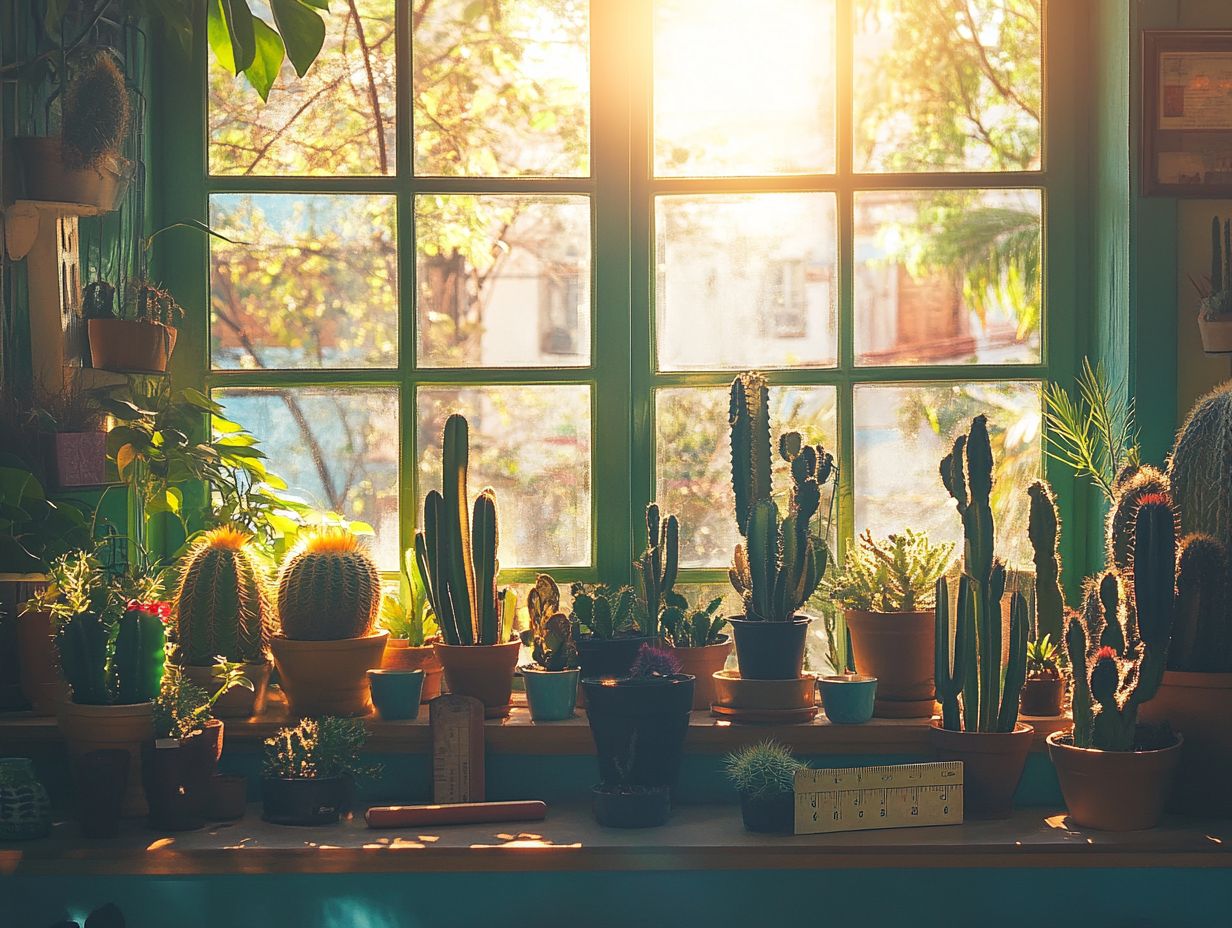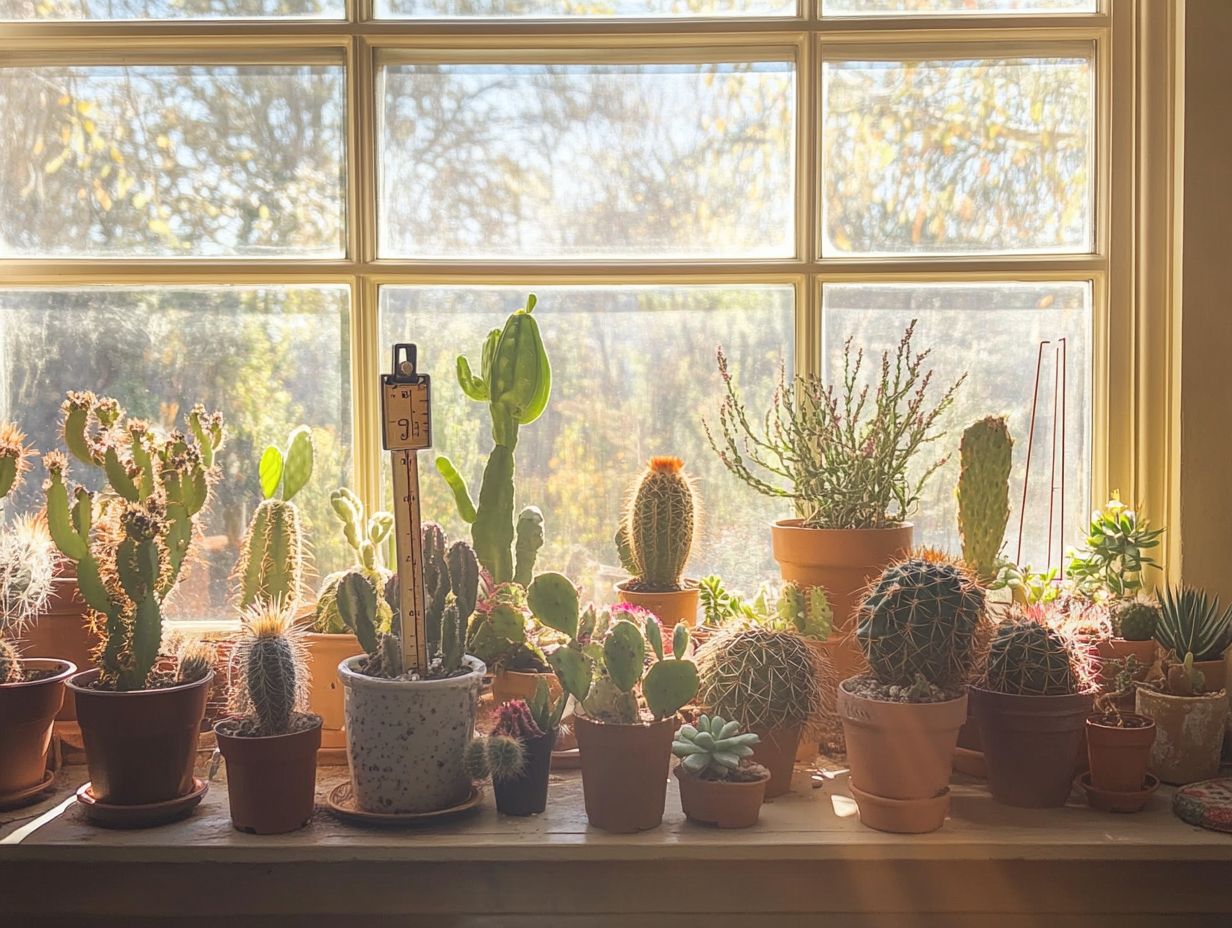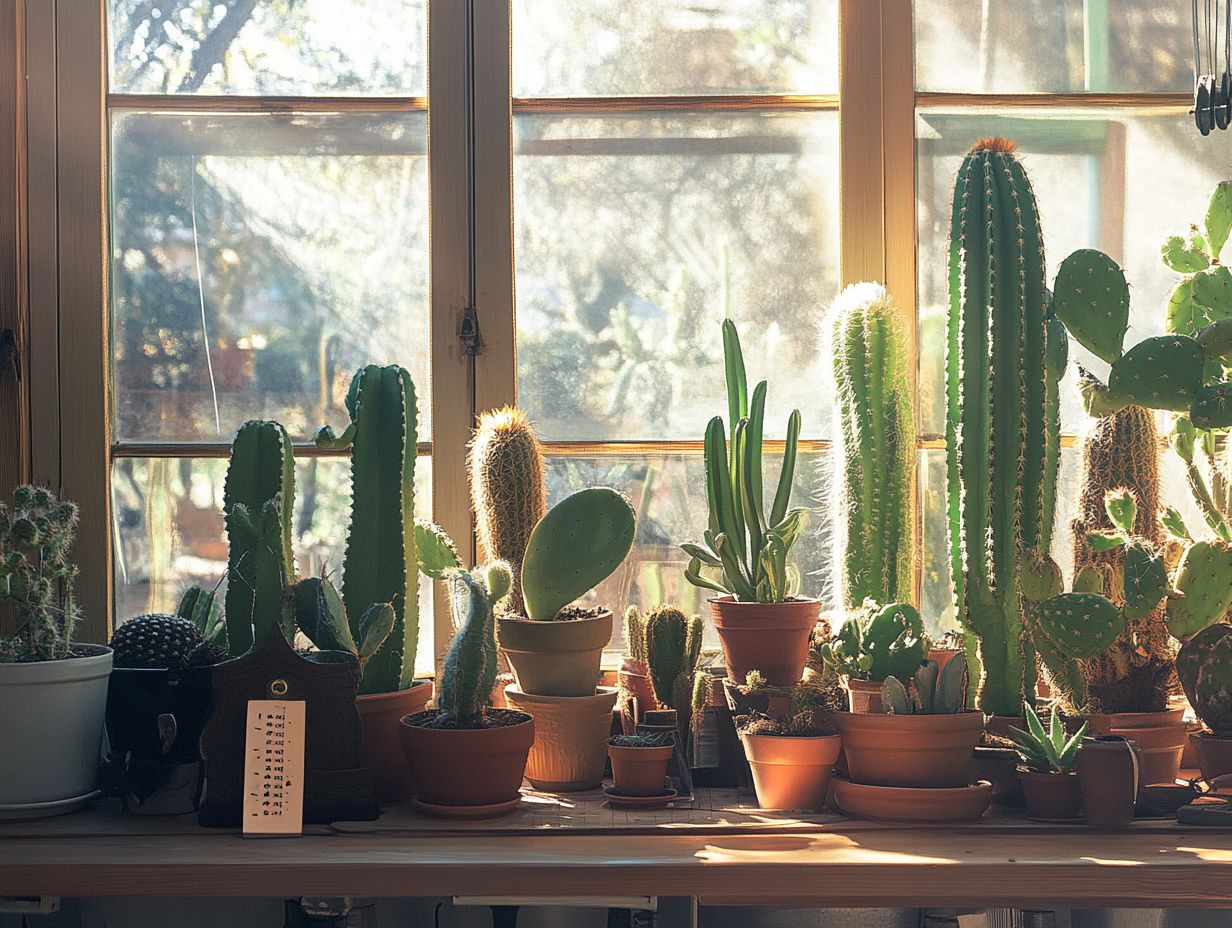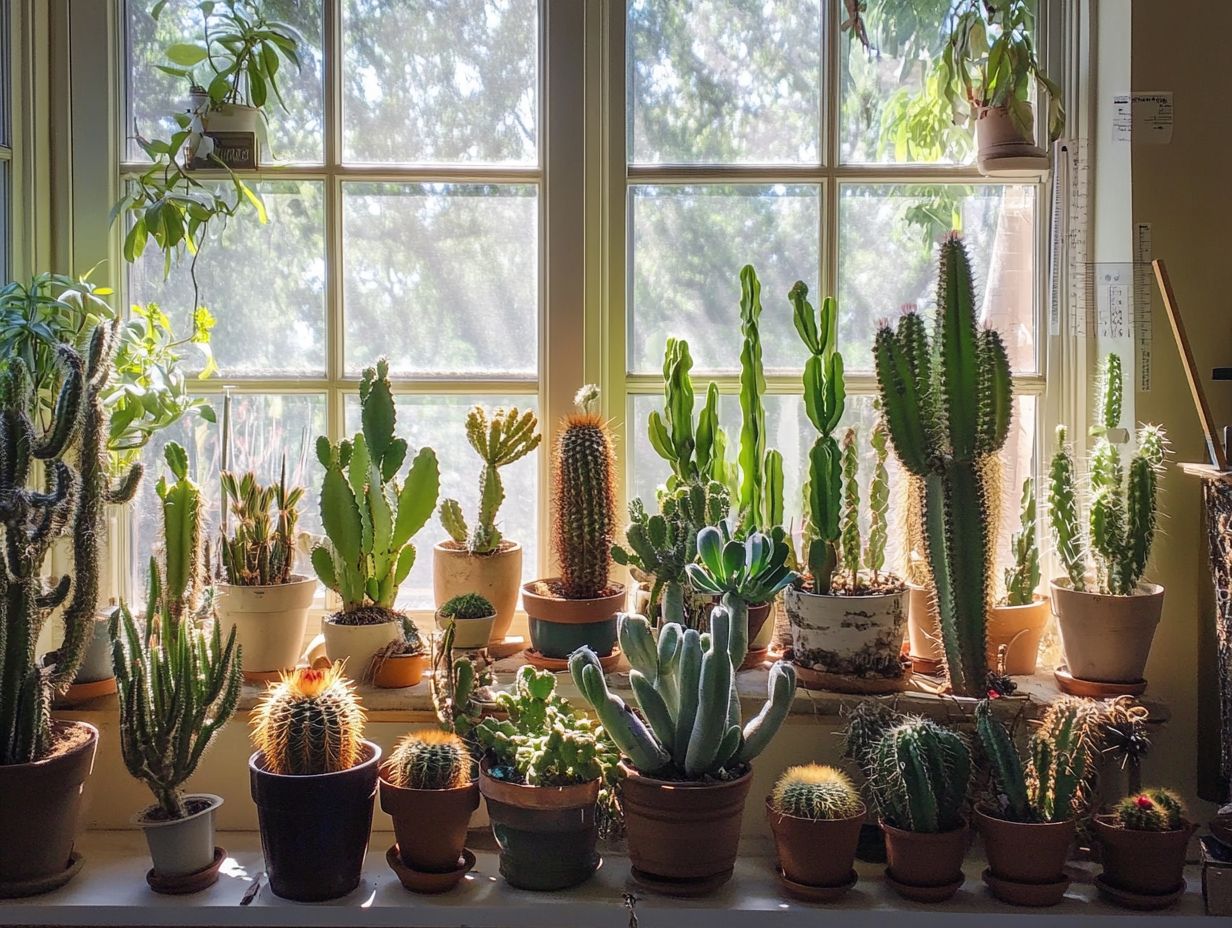Best Sustainable Hotels for Business Travelers
Cacti are truly remarkable plants, flourishing even in some of the harshest conditions on Earth. Their success largely depends on one crucial factor: light.
Grasping the importance of various light types, whether natural or artificial light sources, is essential for promoting healthy growth. This article delves into the specific light requirements of cacti, guiding you on how to create the ideal conditions while identifying common light-related challenges.
You ll uncover practical tips for maintaining optimal light levels, empowering your cacti to thrive like never before.
Contents
Key Takeaways:

- Adequate light is crucial for the growth of cacti, as it affects their photosynthesis, water uptake, and overall health, including factors such as light duration.
- There are two types of light sources for cacti: natural and artificial, and each has its own benefits and limitations.
- Understanding the light requirements of your cacti is essential for providing optimal light conditions, as factors like season, location, and species can all impact their needs.
The Importance of Light for Cacti
Ever wondered why light is so important for your cacti? Grasping the significance of light for cacti is vital for your horticultural success, especially in regions like Tucson, Arizona, where light intensity greatly influences the growth of diverse cactus species, from desert cacti to jungle cacti.
These remarkable plants possess unique adaptations that demand specific light conditions to flourish. Particularly during the scorching summer months, providing summer shade may be necessary. Your understanding of these requirements will be pivotal in cultivating a thriving cactus garden.
Why Light is Essential for Cacti Growth
Light is absolutely essential for your cacti’s growth, as it fuels the process of photosynthesis, converting carbon dioxide into energy.
Different wavelengths of light have a distinct impact on this energy conversion. Blue and red light are particularly effective for optimal photosynthetic activity. For instance, cacti that thrive in arid desert conditions crave intense, direct sunlight to kickstart their growth.
Building the resilience they need to survive in harsh environments is key. Conversely, jungle cacti, which adapt to the dappled light beneath a canopy, flourish with less exposure to those intense rays.
Knowing what light each type of cactus needs helps them grow better. By providing the right light intensity, you can significantly enhance their overall health and growth, ensuring thriving conditions.
Types of Light for Cacti
Understanding the various types of light available for cultivating cacti is crucial for ensuring their optimal growth and health. Whether you opt for natural or artificial light sources, making informed choices is particularly important, especially in controlled environments.
Natural vs Artificial Light
Natural light delivers essential wavelengths vital for the growth of cacti. Artificial light offers versatility in adjusting different types of light and intensities to suit your needs.
Both lighting options come with unique advantages, playing distinct roles in nurturing these resilient plants. During peak summer months, natural light can become overwhelmingly intense, necessitating careful shade management to prevent scorching especially for more delicate species.
On the flip side, artificial light allows you to fine-tune brightness and wavelength, creating tailored growth conditions. Striking a balance between these two sources can significantly enhance growth.
By employing outdoor shades and supplementing with LED grow and fluorescent lights indoors, you can cultivate adaptable conditions that cater to the specific needs of individual species throughout the year.
Understanding Cacti Light Requirements

Understanding how much light cacti need is vital for their health. Factors like light intensity, duration, and specific wavelengths greatly influence their growth and appearance.
By focusing on these elements, you can help your cacti thrive beautifully.
Factors that Affect Light Requirements
Many factors influence the light needs of your cacti. These include the species type, such as Mammillarias, the environmental conditions, and the availability of carbon dioxide, which is essential for the process plants use to make food from sunlight.
For instance, certain species like Mammillarias do best in bright, indirect light. In contrast, Fraileas often prefer shaded conditions. These differences highlight their unique adaptations.
The temperature and humidity levels are also crucial. While higher temperatures may boost photosynthesis rates, they can lead to dehydration if humidity drops too low.
It’s essential to monitor light duration and intensity. This ensures your cacti receive the right energy for healthy growth while avoiding excessive exposure. To learn more about this important aspect of care, check out how to keep track of plant light needs. Achieving the right balance not only supports their survival but also encourages stunning blooms and strong root development.
Providing Adequate Light for Cacti
To provide adequate light for your cacti, understand their specific light requirements and follow best practices for placement and light exposure. Doing so ensures they have a bright, thriving environment.
Best Practices for Placement and Light Exposure
Best practices for placing cacti involve positioning them to receive optimal light intensity while considering their individual needs.
Whether indoors or outdoors, evaluate factors such as the direction of sunlight and any nearby obstructions that might block light.
For indoor placement, position your cacti near south or west-facing windows to maximize direct sunlight.
In outdoor settings, consider using raised beds or pots that allow for proper drainage and sun exposure.
If you’re in an area with limited natural light, fluorescent lights or LED grow options make excellent alternatives. These artificial sources can effectively mimic sunlight, ensuring your cacti thrive even in less-than-ideal conditions.
Common Light-Related Issues for Cacti
Light-related issues can significantly affect the growth and health of your cacti. Challenges may include insufficient light, excessive light exposure, and the risk of etiolated growth in your seedlings.
Addressing these concerns is crucial for nurturing robust and thriving plants.
Signs of Insufficient or Excessive Light

Recognizing the signs of insufficient or excessive light such as pale coloration or sunburn is vital for your cacti’s care. These indicators can help you identify problems before they escalate.
Etiolated growth, characterized by elongated stems and sparse leaves, often signals a lack of adequate light. If you see pale coloration, your plants are likely stretching toward their light source.
Conversely, signs of sunburn, like bleached patches or browning tips, indicate too much sunlight. To resolve these issues, adjust their position or provide filtered light. This can greatly enhance their overall health.
Consider using sheer curtains to diffuse harsh sunlight or relocating them to a brighter corner. This will create a balanced lighting environment that fosters thriving growth.
Make sure to check your cacti’s light exposure regularly!
Tips for Maintaining Optimal Light Conditions
To achieve optimal light conditions for your cactus, regularly monitor and adjust the light levels. Consider its growth patterns and any changes in the environment. This attentive approach ensures your cactus thrives in its unique habitat.
How to Adjust Light Levels for Cacti
Find the ideal spot for each plant! Manage the intensity of artificial lights, whether you re using fluorescent or LED grow lights.
By moving your cacti closer to windows or artificial light sources, you can enhance their exposure to those beneficial rays. For more detailed insights on how to achieve the optimal light conditions for succulents, consider adjusting their placement. If you notice your plants stretching or turning yellow, it’s a sign they may be getting too much light. In that case, reposition them further away or dial down the light intensity.
Regularly check the health of your cacti. Look for any changes in coloration or growth patterns these are key indicators of how well your light adjustments support their overall well-being.
Your Top Cactus Light Questions Answered!
What are the light requirements for cacti?
Cacti love bright, indirect light, but their needs can vary by species. Avoid full sunlight to prevent sunburn!
How do I know if my cactus is getting enough light?

If your cactus is not getting enough light, it may start to stretch and become taller and thinner, leading to tall and spindly growth. This means it s trying to reach for more light. On the other hand, if your cactus gets too much light intensity, it may become discolored or develop sunburn patches.
Can I use artificial light for my cactus?
Yes, you can use artificial light to supplement the natural light for your cactus. LED grow lights are a popular option, as they mimic the light spectrum of natural sunlight and can be adjusted to provide the optimal amount of light for your cactus, including blue light for better growth.
How many hours of light do cacti need?
Aim for 6 to 8 hours of bright, indirect light daily. However, this can vary depending on the species, such as jungle cacti or desert cacti, and the amount of natural light available in your home. Research the specific light requirements of your cactus to ensure it is getting enough light.
Can I keep my cactus outside in full sun?
It is not recommended to keep your cactus in full sun, as this can damage the plant. If you want to keep your cactus outside in sunny Tucson, Arizona, ensure it is in a location that receives bright, indirect light for most of the day, especially during the intense summer heat.
What should I do if my cactus is not getting enough light?
Don t wait if your cactus seedlings are struggling! Move them to a brighter spot today! If that isn t possible, supplement with artificial light, like compact fluorescents or T8 fluorescents. Also, ensure your cactus is not being overwatered, as this can impact its health and growth, affecting processes like CAM photosynthesis.
With these tips in hand, your cacti will flourish. Start adjusting their light today for a healthier, happier plant!






